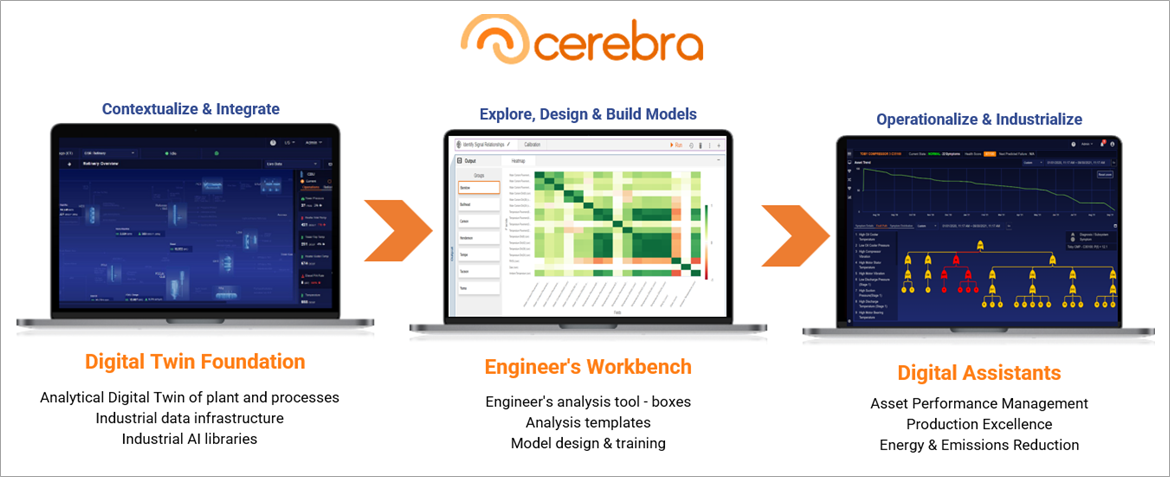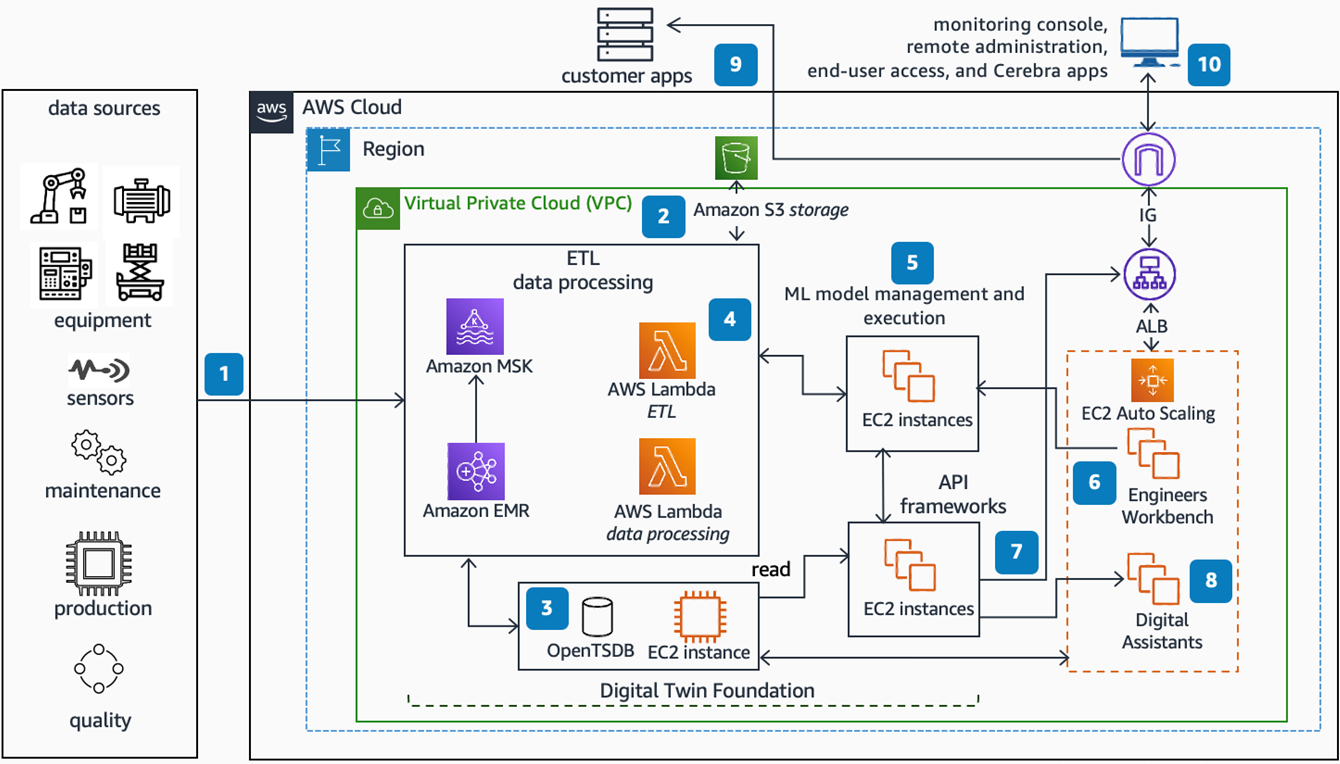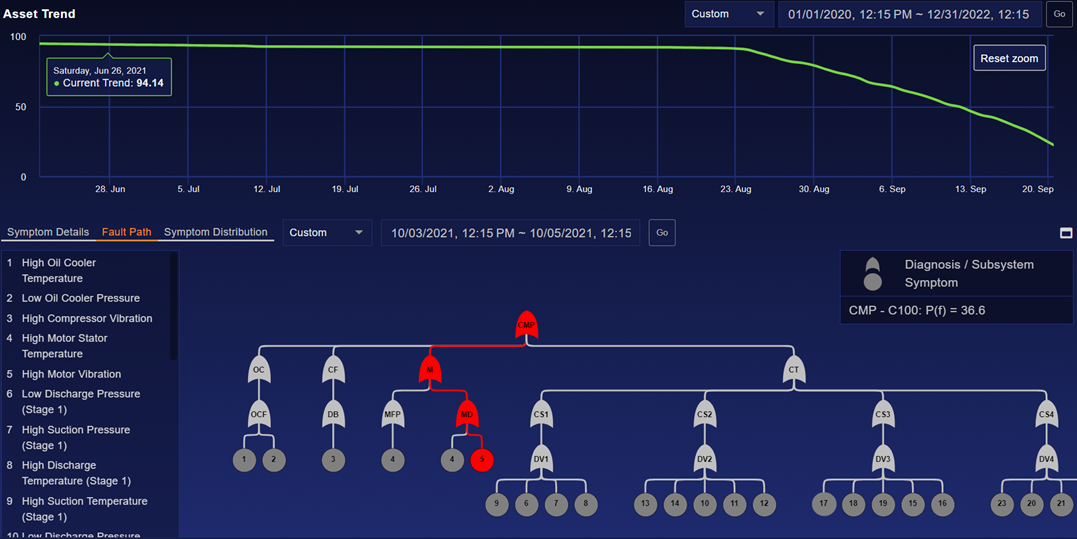AWS Partner Network (APN) Blog
Reduce Asset Downtime and Optimize Performance Using Accenture Industrial Intelligence Suite on AWS
By Madhu Pai, Ph.D., Principal Partner Solutions Architect, Manufacturing – AWS
By Marcos Kajita, Principal Partner Solutions Architect, Energy – AWS
By Arun Anand, Sr. Partner Solutions Architect, Power & Utilities – AWS
By Jigar Doshi, Head of Industrial AI – Accenture
 |
| Accenture |
 |
Energy and process manufacturers are looking for mechanisms to predict asset breakdowns well before actual asset failure.
Technologies such as artificial intelligence (AI) and machine learning (ML) are being evaluated and deployed to achieve better decision-making ability, improve reliability, and gain greater operational efficiencies while driving sustainable growth.
As AI/ML methods rely upon historical and near real-time data, customers can encounter challenges in achieving production-ready solutions, such as integrating data from disparate systems and modeling data at scale. These solutions need to collect, process, and analyze data from a variety of sources, including enterprise applications and a multitude of assets.
In this post, we discuss how Accenture Industrial Intelligence Suite addresses these challenges by using a strong data foundation, collecting and processing data from a variety of assets at scale. Accenture Industrial Intelligence Suite employs AI/ML models along with scalable AWS services to mitigate unplanned downtime, optimize asset performance, and improve asset reliability.
We will provide an overview of Accenture Industrial Intelligence Suite on Amazon Web Services (AWS), describe the reference architecture for a typical deployment on AWS, and present a real-world case study where it was used to predict asset downtime and optimize asset performance.
Accenture is an AWS Premier Tier Services Partner and Managed Service Provider (MSP) that provides an end-to-end solution to migrate to and manage operations on AWS. By working with the Accenture AWS Business Group (AABG), a strategic collaboration by Accenture and AWS, organizations can accelerate the pace of innovation to deliver disruptive products and services.
Accenture Industrial Intelligence Suite
Accenture Industrial Intelligence Suite on AWS solution is an industrial AI platform that offers customized AI-powered digital assistants for specific use cases.
This helps operations, production, and quality teams manage day-to-day industrial operations and improve their decision-making, while running large-scale, complex operations such as manufacturing plants, oil and gas fields, and refineries.
The solution’s Digital Twin Foundation module integrates data from disparate sources, ensures data quality, and prepares the data to build reliable models that can be used by engineers, all at scale.
Accenture Industrial Intelligence Suite incorporates a universal machine and process data model that’s compliant with International Organization for Standardization (ISO), International Society of Automation (ISA), Greenhouse Gas (GHG) Protocol, and other industry-focused frameworks and standards.
It provides a rich set of no-code, self-service workbenches to contextualize the data model per user needs. This contextualization includes capturing design and capacity constraints of the plant, operating range of critical measurements, fault modes, baselines, and performance curves.
The complete Digital Twin Foundation can be deployed in the customer’s AWS account through AWS CloudFormation, which lets you model, provision, and manage AWS and third-party resources, or can be hosted as software-as-a-service (SaaS).
The Engineer’s Workbench allows industrial engineers to perform a variety of data analytics and data science activities by combining strong industrial domain knowledge in chemical, mechanical, or process engineering.
As there are typically hundreds of thousands of equipment types in large industrial facilities, building, deploying, and managing models associated with these assets on an ongoing basis is a non-trivial task.
Some of the challenges encountered in model management are preparing the data for specific analyses, evaluating the feasibility of building models, and assessing the impact of model predictions on business outcomes. An added challenge is scaling the analyses to a large number of assets and processes.
The Engineer’s Workbench helps address these challenges through a variety of toolboxes associated with data quality checks, comprehending signal patterns, understanding relationships between various operational parameters, anomaly detection, and training and building models. Once a model has been evaluated for its performance, Accenture Industrial Intelligence Suite allows for publishing the model for operational use.
Digital assistants enable the deployment of industrial AI solutions to facilitate day-to-day operational decision-making through a browser-based application with a user interface (UI) that engineers, data scientists, and operations management personnel can use to drive decisions.
Digital assistants include a variety of capabilities for rotary and static equipment such as asset diagnostics, asset health index, anomaly detection, failure prediction, asset performance optimization, and fleet management.
Figure 1 – Modules in Accenture Industrial Intelligence Suite on AWS.
Reference Architecture
Figure 2 shows the reference architecture for Accenture Industrial Intelligence Suite on AWS that’s based on the AWS Well-Architected Framework. A description of the data flow among the various components is given below.
Figure 2 – Accenture Industrial Intelligence Suite architecture on AWS.
- Accenture Industrial Intelligence Suite ingests data directly from sensors, historians, and local databases as data streams or in batch. Data sources may exist in on-premises or in a cloud environment.
- The extract, transform, load (ETL) component on Accenture Industrial Intelligence Suite is capable of handling large volumes of data using Amazon Elastic MapReduce (Amazon EMR) to generate Spark jobs on demand. As raw data is processed, data is split into Kafka streams in Amazon Managed Streaming for Apache Kafka (Amazon MSK) to ingest and process streaming data for further processing.
- Data streams from the ETL component are processed through additional Spark jobs on Amazon EMR before they are stored in Amazon Simple Storage Service (Amazon S3) or in a time series database such as OpenTSDB.
- AWS Lambda is used to synchronize different data streams with metadata also stored on S3.
- Accenture Industrial Intelligence Suite model management facilitates registration of new containerized models, management of model versions, model performance, and initiation of automated or manual retraining of models. This component consumes Kafka streams from Amazon MSK.
- Data streams are processed by models generated by the Engineer’s Workbench. Additional compute power is provided by Amazon Elastic Compute Cloud (Amazon EC2), and EC2 Auto Scaling which monitors your applications and automatically adjusts capacity.
- Accenture Industrial Intelligence Suite API Framework components run on Amazon EC2. It has several pre-built asset-centric and process-centric use case frameworks along with their associated diagnostics and algorithms to support various decision-making processes for reliability and process optimization engineers.
- Accenture Industrial Intelligence Suite digital assistants form the core part of the solution for industrializing and supporting operational decision-making. The browser-based application component is hosted on EC2 servers in a highly scalable and available mode. It provides the UI that allows engineers, data scientists, and operations management personnel to drive day-to-day decisions.
- Accenture Industrial Intelligence Suite allows customers to directly access data stored in OpenTSDB via Application Load Balancer (ALB) as reverse proxy.
- Accenture Industrial Intelligence Suite provides browser-based console access for monitoring, remote administration, end-user access and for working with many apps via the internet gateway (IGW) and an ALB.
In summary, the Digital Twin Foundation module in Accenture Industrial Intelligence Suite (see Figure 1) subsumes (1) the ETL component that uses Amazon EMR and Amazon MSK; (2) the data processing and storage layer that consists of S3 and a time-series database such as OpenTSDB; (3) model management and implementation that leverages EC2 and Auto Scaling; (4) the API Framework running on EC2; and (5) the Accenture Industrial Intelligence Suite API Framework components that run on EC2.
Typical Workflow
Next, we will present a real-world case study for a continuous process plant that used the AI/ML capabilities of Accenture Industrial Intelligence Suite to detect early onset of failure of its critical physical assets at one of its major facilities in the U.S. with a processing capacity of 500 million cubic feet per day (MMCFD).
The customer has stringent goals to avoid flaring, which is the result of unplanned downtime in physical assets such as compressors. The plant leveraged asset performance monitoring, asset health diagnostics, and asset health prediction and forecasting, leading to the prevention of three critical failures within a span of six months. This resulted in an estimated savings of $3-4.5 million.
Figure 3 depicts the process used to deploy Accenture Industrial Intelligence Suite at the plant, starting from inception to production, once the requirements were laid out by the customer.
Figure 3 – Deployment process of Accenture Industrial Intelligence Suite.
Once the readiness assessment and the Accenture Industrial Intelligence Suite platform setup was completed, the deployment commenced with the creation of a digital replica of the entire equipment fleet: a digital twin with 20+ compressors across different processing units.
As an example, Figure 4 shows the digital twin of the compressor unit created in Accenture Industrial Intelligence Suite. This is currently being scaled to 200 assets with 8,000+ sensors.
Figure 4 – Digital twin of compressor unit.
The digital twin is primarily an asset metadata model that’s created based on ISO standards. This helps contextualize different streams of data to their specific equipment and process units, and tie together various design specifications, fault modes, and performance curves along with time series sensor data. This digital twin module is configurable and enables the customer to scale to thousands of assets rapidly.
Once the digital twin was created, sensor data, repair and maintenance data, equipment specifications (such as horsepower, energy consumption, and pressure), and field measurements from multiple data sources (such as PI Historian and SAP), were ingested into Accenture Industrial Intelligence Suite by leveraging AWS services.
Accenture Industrial Intelligence Suite has plugins and data integration frameworks to integrate data from SCADA systems, historians, enterprise resource planning (ERP), manufacturing execution systems (MES), lab information management systems (LIMS), and even customers’ homegrown systems.
Furthermore, the ETL component on Accenture Industrial Intelligence Suite has been designed for performance and scalability, and is capable of handling large volumes of data as it uses Amazon EMR and Amazon MSK. Being managed services, Amazon EMR and MSK lowered the maintenance cost for the customer.
Subsequent to the data ingestion and mapping, the data was pre-processed using the Engineer’s Workbench. This brings in the capabilities to accelerate data analysis and the model building process, enabling plant engineers to carry out the entire analysis by themselves with the help of pre-configured toolboxes.
In this case, two years of historical data (primarily sensor and maintenance records) were ingested by the Engineer’s Workbench for training the models.
Figure 5 – Engineer’s Workbench output.
Algorithms such as auto-encoders and clustering were used to identify point anomalies and causal factors of degradation, resulting in quicker root cause analysis and eventually reduced unplanned downtime.
Machine learning algorithms such as Random Forest, XG-Boost, Light GBM, and Catboost were trained and deployed for early prediction and forecasting of failures, which included compressor valve failure, motor failure, bearing failure, shaft failure and heat exchanger failure.
Digital assistants deployed at this customer were the asset health monitoring and asset failure prediction, among other possible digital assistants for process unit performance, energy efficiency, and hybrid simulation modeling.
Figure 6 shows the compressor health degradation and corresponding automated fault path generated by the model. The fault path analysis indicates motor failure and high motor vibration, which helps the plant engineer to quickly diagnose the root cause of any potential issues and schedule the work order for the same.
Figure 7 – Motor failure prediction and fault path analysis.
Accenture Industrial Intelligence Suite helped the customer manage assets at scale and provide intelligent digital solutions, resulting in reduced unplanned downtime and increased operational efficiency.
Some of the key business benefits delivered as part of the customer deployment were:
- 90%+ accuracy of prediction models for different failure modes such as bearing failure and valve failure.
- 7-25 days lead time for critical events helping reduce unplanned downtime.
- $3-5 million estimated savings by preventing large compressor failures.
Summary
Accenture Industrial Intelligence Suite enables industrial customers to predict degradation of assets, avoid unnecessary downtime, and improve overall operational performance.
Accenture provides asset-centric applications such as predictive maintenance, and process-centric applications like quality benchmarking and diagnostics, automated root-cause analysis, and energy optimization. To facilitate data ingestion from industrial operational technology systems, Accenture Industrial Intelligence Suite supports integration with over 70 standard and customized industry connectors.
Using a real-world customer case study, we described the typical workflow of deployment of Accenture Industrial Intelligence Suite at a customer’s site. We delved into the process of data ingestion from a variety of data sources, data transformation, model building using AI/ML technologies as well as physics-based models, and model deployment.
We also showed how Accenture’s Digital Twin Foundation and Engineer’s Workbench enabled industrial engineers to quickly arrive at data-driven insights to help in operational decision-making.
Review more case studies where Accenture customers have deployed Accenture Industrial Intelligence Suite applications on AWS for 1) a vast fleet of rotary, and 2) static equipment across industries to prevent unplanned downtime. You can also learn more about Accenture Industrial Intelligence Suite on AWS Marketplace.
Accenture – AWS Partner Spotlight
Accenture is an AWS Premier Tier Services Partner and MSP that provides an end-to-end solution to migrate to and manage operations on AWS. By working with the Accenture AWS Business Group (AABG), a strategic collaboration by Accenture and AWS, organizations can accelerate the pace of innovation to deliver disruptive products and services.






